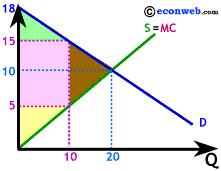

Copyright © 1995-2004 OnLineTexts.com, Inc. - All Rights Reserved
 A simple numerical example is shown to the right. Suppose for some market the allocatively efficient level of output is 20 at a market price of 10. Suppose instead only 10 units are produced. Because only 10 units are available, consumers are willing to pay a price of 15, even though sellers are willing to supply this quantity at a price of 5.
A simple numerical example is shown to the right. Suppose for some market the allocatively efficient level of output is 20 at a market price of 10. Suppose instead only 10 units are produced. Because only 10 units are available, consumers are willing to pay a price of 15, even though sellers are willing to supply this quantity at a price of 5.
Total surplus is reduced by 50, an amount equal to the yellow shaded area. Total surplus if 20 units are produced and sold at a price of 10 is 180. In this case underproducing leads to a loss of over 27% of total surplus.


Copyright © 1995-2004 OnLineTexts.com, Inc. - All Rights Reserved